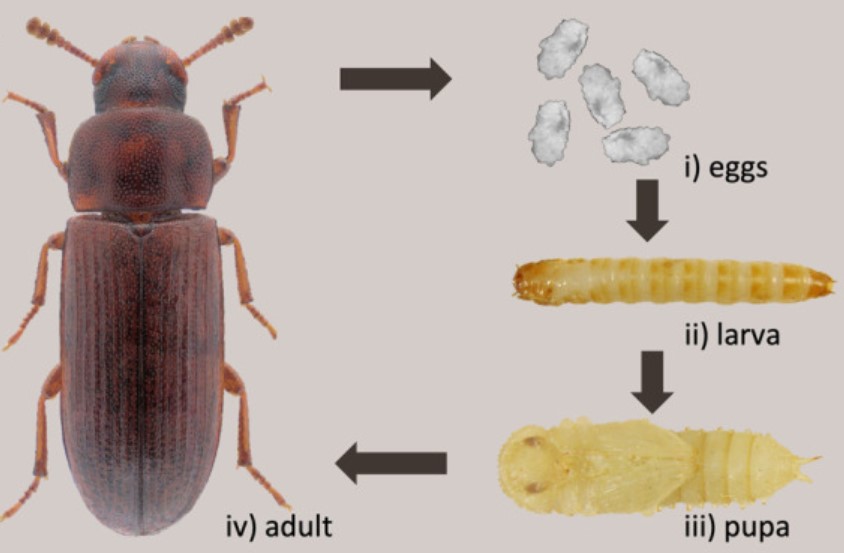Tribolium castaneum belongs to coleoptera and is a highly damaging worldwide pest of grain storage. They not only feed directly on grain, but also the stink glands of adult insects can secrete stinky liquid, which contains carcinogenic benzoquinone, and when it occurs in large quantities, it can lead to stinky grain and lumpy mold, causing serious economic losses. At present, the use of insecticides is the main method of controlling tribolium castaneum. However, the long-term use of insecticides has led to increasing resistance to chemical control. Therefore, it is important to find new measures for the control of tribolium castaneum.
 Figure 1. Tribolium castaneum life stages. (Pointer MD., et al., 2021)
Figure 1. Tribolium castaneum life stages. (Pointer MD., et al., 2021)
As the first coleopteran pest to have its whole genome sequenced, tribolium castaneum has developed into an important model insect, but its functional genomics research is still in its infancy, and further studies are needed on how many genes function in tribolium castaneum. Lifeasible is able to help customers to perform functional analysis of differentially expressed genes during the growth and development of tribolium castaneum and the development of insecticide resistance through sophisticated gene editing technology, providing ideas for the study of tribolium castaneum biology and the search for new insecticide targets.
We have a proven technology for the construction of PiggyBac transposon vectors. We co-transformed the target cells with the helper plasmid and transposon plasmid. The helper plasmid is able to encode transposase to recognize the inverted terminal repeats at both ends of the transposon plasmid and cleave it, and the optimized inverted terminal repeats can insert a 10 Kb-20 Kb sequence. The released transposable region is then integrated into the host genome by transposase. We are able to use piggyBac-mediated genomic manipulation technology to help our customers construct a mutation system for tribolium castaneum, perform large-scale transposon mutagenesis screening, and find new ways to control tribolium castaneum.
 Figure 2. Organization and functional domains of piggyBac. (Sandoval-Villegas N., et al., 2021)
Figure 2. Organization and functional domains of piggyBac. (Sandoval-Villegas N., et al., 2021)
RNA interference technology means that double-stranded RNA homologous to the target gene causes degradation of the mRNA encoding the gene, thereby specifically inhibiting the expression of the gene. tribolium castaneum. is the only insect with a systemic RNA interference mechanism as efficient as that of Scottnema. Injecting double-stranded RNA into larvae, pupae, adults, and embryos at any stage of life can suppress the expression of target genes, and the suppressive effect can be extended to the next generation. We are able to help our customers accelerate functional genomics studies of tribolium castaneum through RNA interference technology.
We have extensive experience in gene editing using CRISPR technology and have constructed promoters and constructs of Cas9 and gRNA capable of implementing CRISPR technology in tribolium castaneum. We are able to help customers to achieve knockout and knock-in of target genes in the tribolium castaneum.
Lifeasible can provide piggyBac-mediated gene manipulation services, RNA interference services, and CRISPR/Cas9-mediated gene editing services to help customers solve the problems encountered in the process of gene editing for tribolium castaneum. If you are interested in our services or if you have any questions, please click online inquiry for more detailed information.